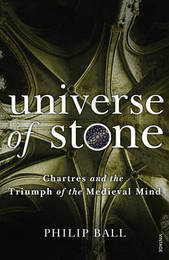
|
Universe of Stone
Paperback / softback
Main Details
| Title |
Universe of Stone
|
| Authors and Contributors |
By (author) Philip Ball
|
| Physical Properties |
| Format:Paperback / softback | | Pages:336 | | Dimensions(mm): Height 198,Width 132 |
|
| Category/Genre | Religious buildings
Church history |
|---|
| ISBN/Barcode |
9780099499442
|
| Classifications | Dewey:726.50944510902 |
|---|
| Audience | |
|---|
|
Publishing Details |
| Publisher |
Vintage Publishing
|
| Imprint |
Vintage
|
| Publication Date |
30 April 2009 |
| Publication Country |
United Kingdom
|
Description
1) In the twelfth century, Christians in Europe began to build a completely new kind of church not the squat, gloomy buildings we now call Romanesque, but soaring, spacious monuments flooded with light from immense windows. 2) The inception of the age of Gothic architecture in the late twelfth century marked a profound change in the way some prominent Western intellectuals and theologians pictured the Universe and humanity's realtionship with it. 3) They began to imagine a God who built the cosmos using logical rules , based on geometry, that mankind could deduce using the faculty of reason. 4) This faith in an ordered, rational and harmonious universe was given physical expression in the great cathedrals, and more than any other in Chartres Cathedral, an unparalleled feat of craftsmanship in which all the elements of the new style cohered perfectly for the first time. 5) This change in thinking was by no means universal, and it led to furious debates about how far it was proper to enquire into the nature of the universe. These conflicts marks the beginning of the tensions that are still felt today between faith and reason. 6) Universe of Stone establishes Chartres Cat
Author Biography
Philip Ball is a freelance writer and a consultant editor for the world's leading science journal Nature. He is a regular commentator on the interactions between science, art, history and culture. His previous books include Bright Earth- The Invention of Colour, H2O- A Biography of Water and Critical Mass- How One Thing Leads To Another, which won the 2005 Aventis Prize for Science Books.
Reviews"[Ball] has a knack for translating difficult concepts into lucid prose: he offers a refreshingly sceptical guided tour of Chartres Cathedral and the intellectual contents that helped produce it" Daily Telegraph "Lucid and resplendent...a model of explanatory writing" -- John Carey Sunday Times "Consistently and healthily sceptical ... an intelligent, enjoyable and well-produced book which deserves a wide audience" Times Literary Supplement "An original and imaginative synthesis of art history and history of science" History Today "Lucid and resplendent" The Times
|